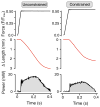Resistance to radial expansion limits muscle strain and work
- PMID: 28432448
- PMCID: PMC5889119
- DOI: 10.1007/s10237-017-0909-3
Resistance to radial expansion limits muscle strain and work
Abstract
The collagenous extracellular matrix (ECM) of skeletal muscle functions to transmit force, protect sensitive structures, and generate passive tension to resist stretch. The mechanical properties of the ECM change with age, atrophy, and neuromuscular pathologies, resulting in an increase in the relative amount of collagen and an increase in stiffness. Although numerous studies have focused on the effect of muscle fibrosis on passive muscle stiffness, few have examined how these structural changes may compromise contractile performance. Here we combine a mathematical model and experimental manipulations to examine how changes in the mechanical properties of the ECM constrain the ability of muscle fibers and fascicles to radially expand and how such a constraint may limit active muscle shortening. We model the mechanical interaction between a contracting muscle and the ECM using a constant volume, pressurized, fiber-wound cylinder. Our model shows that as the proportion of a muscle cross section made up of ECM increases, the muscle's ability to expand radially is compromised, which in turn restricts muscle shortening. In our experiments, we use a physical constraint placed around the muscle to restrict radial expansion during a contraction. Our experimental results are consistent with model predictions and show that muscles restricted from radial expansion undergo less shortening and generate less mechanical work under identical loads and stimulation conditions. This work highlights the intimate mechanical interaction between contractile and connective tissue structures within skeletal muscle and shows how a deviation from a healthy, well-tuned relationship can compromise performance.
Keywords: Collagen; ECM; Intramuscular pressure; Muscle; Muscle fibrosis.
Figures




References
MeSH terms
Grants and funding
LinkOut - more resources
Full Text Sources
Other Literature Sources

